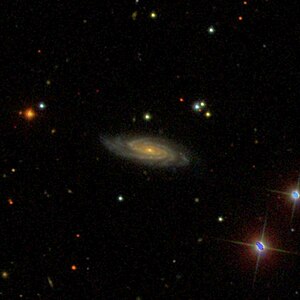NGC 2600
| Galaxie NGC 2600 | |
|---|---|
 | |
| SDSS-Aufnahme | |
| AladinLite | |
| Sternbild | Großer Bär |
| Position Äquinoktium: J2000.0, Epoche: J2000.0 | |
| Rektaszension | 08h 34m 45,0s[1] |
| Deklination | +52° 42′ 56″[1] |
| Erscheinungsbild | |
| Morphologischer Typ | Sb / LINER[1] |
| Helligkeit (visuell) | 14,2 mag[2] |
| Helligkeit (B-Band) | 15,0 mag[2] |
| Winkelausdehnung | 1,2′ × 0,4′[2] |
| Positionswinkel | 78°[2] |
| Flächenhelligkeit | 13,3 mag/arcmin²[2] |
| Physikalische Daten | |
| Zugehörigkeit | WBL 186-001[1] |
| Rotverschiebung | 0.044879 ± 0.000013[1] |
| Radialgeschwindigkeit | (13454 ± 4) km/s[1] |
| Hubbledistanz H0 = 73 km/(s • Mpc) | (603 ± 42) · 106 Lj (184,9 ± 12,9) Mpc [1] |
| Durchmesser | 210.000 Lj[3] |
| Geschichte | |
| Entdeckung | Guillaume Bigourdan |
| Entdeckungsdatum | 7. März 1886 |
| Katalogbezeichnungen | |
| NGC 2600 • UGC 4475 • PGC 24082 • CGCG 263-055 • MCG +09-14-068 • IRAS F08310+5253 • 2MASX J08344506+5242566 • GALEXASC J083445.24+524256.6 | |
NGC 2600 ist eine Spiralgalaxie mit aktivem Galaxienkern vom Hubble-Typ Sb im Sternbild Großer Bär am Nordsternhimmel. Sie ist schätzungsweise 603 Millionen Lichtjahre von der Milchstraße entfernt und hat einen Durchmesser von etwa 215.000 Lichtjahren.
Im selben Himmelsareal befinden sich u. a. die Galaxien NGC 2602, NGC 2603, NGC 2605, NGC 2606.
Das Objekt wurde am 7. März 1886 von dem Astronomen Guillaume Bigourdan entdeckt.[4]
Weblinks
Einzelnachweise
Auf dieser Seite verwendete Medien
Autor/Urheber: Sloan Digital Sky Survey, Lizenz: CC BY 4.0

Angle of view: 4' × 4' (0.3" per pixel), north is up.
Details on the image processing pipeline: https://www.sdss.org/dr14/imaging/jpg-images-on-skyserver/